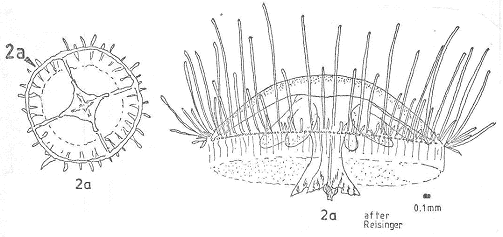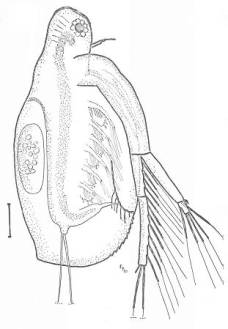2 a. Body with radial symmetry:
COELENTERATA (phylum);
HYDROZOA (class)
Craspedacusta, Freshwater medusae
With small solitary polyps and free-swimming medusae.
In freshwater. Size 20000 μm (20 mm).
Food of polyp and medusae: Asplanchna, copepods.
Although no recent records are known, it might still
be found (Terry L. Peard, Ph.D. personal communication).
Se lifecycle from (http://www.jellyfish.iup.edu/).Craspedacusta sowerbyi, (LANKESTER)
(syn. C. sowerbii)
[Roxas 1936, in Reisinger, 1972]

2 b. Body with bilateral symmetry.......................................3
3 a. Small animals with ciliated crown or corona (wheel organ).
Body without segments. No legs present,
with or without tail like foot. Suspension feeding via coronal cilia
Food: Bacteria, algae, detritus. Planktonic or bentic:ROTIFERA, Rotifers or Wheel animacules (phylum)..................7

3 b. Body segmented (with metamery):
ARTHROPODA, Arthropods (phylum)..................................4
4 a. Without jointed legs, (larvae) transparent, except for the black
air-sacs, of which one pair lies in thorax and one pair lies
near the end of abdomen. As fig. 4a.(INSECTA, Insects (Class)
DIPTERA, True flies (order)
Chaoborus (syn. Corethra), Phantom midge-larvae.
Third and fourth larval instars planktonicduring night, bentic during day. With vertical
migration.
Food: zooplankton and midge-larvae (Chironomids).
In Lake Lanao Chaoborus is responsible for the major
mortality of its pry (Thermocyclops, Tropodiaptomus,
Diaphanosoma, Moina, Bosmina and Keratella). In lakes.
- Lake Lanao (C.sp = Ekstein 1)
Chaoborus manilensis, (SHINER)
[1969, Lewis 1977, 1979b]
4 b. With legs.
CRUSTACEA, Crustaceans (class)................................5
5 a. Without a shell-like covering of the body, with up to five pairs
of 2-branched swimming legs (might have a 6th rudimentary
pair of leg). Abdomen without appendages.
Size 100-2000 μm. Filtratory and/or raptorial.
Food: Algae, detritus and zooplankton.
COPEPODA, Copepods (subclass)...............................100
5 b. With a shell-like covering, which may or
may not entirely cover the body...............................6
6 a. Bivalve shell enclosing the entire body. Body not distinctly
segmented. Legs not leaf-like. Size 100-1000 μm. Planktonic
species, omnivorous, feeding on algae and detritus. (Fig. 6a:
anatomy of ostracod and sample from Laguna de Bay).
OSTRACODA, Mussel shrimps (class)
CYPRIDIDAE, BAIRD 1845 (family)
Only few records. Victor (2002) gives a key to 17 genera likely to occur in Western tropical freshwaters. Following has now intention to be complete overview of the Philippine mussel shrimps:
STRANDESIA, VAVRA, 1895.
- Lake Lanao, rice fields.
Strandesia wolterecki, TRESSLER 1937.
(syn. Strandesia chondropherusa Rome, 1965)
(syn. Strandesia regularis Rome, 1962)
[1937d, 1981a,b, 2005b(key)]- Ponds in Bocolod Chico, Mindanao.
Strandesia wierzejskii (Grochmalicki, 1915)
[1981a]Other species of Strandesia found in the Philippines:
Strandesia. calapanensis Tressler, 1937
Strandesia. complexa Victor and Fernando, 1982
Strandesia. sexpunctata Klie, 1932
Strandesia. purpurascens (Brady, 1886),
(see 1981a, 2005b(key))
STENOCYPRIS, SARS 189
Endemic species in
- Laguna de Bay
Stenocypris derupta VAVRA[1981e, 2002a]
CYPRIA, ZENKER 1854Adapted for benthic life, but frequently appearing in
plankton collections
- Mindanao
Cypria (Cypris) spinifera, TRESSLER, 1937
[1981a, 2002]
EUCYPRIS Planktonic genus.
Endemic species.
- Laguna de Bay [type locality].
Eucypris bayensis, TRESSLER, 1937
[1941, 1981a,b]
and
- Roadside ditch on Camaguin Island, 1932.
Eucypris orca, TRESSLER, 1937
[1941, 1981a,b]
HETEROCYPRIS, CLAUS 1892.
Dominating the invertebrate fauna together with Eucyclops serrulatus in IRRI (International Rice Research Institute, Los Baños, Luzon. In wetland rice fields it has a limiting effect of grazing on Inoculation of non-indigenous Blue Green Algae strains was establishment, but other factors were involved.
- Ricefield floodwater, IRRI.
Heterocypris lozonensis Neale,
[1981d, 1998b]
Ostracod from Laguna de Bay
6 b. Bivalved shell (Carapace) covers the body but leaves the head free.
Legs leaf-like. Size 200-1500 μm. Filtrators, with filter setae
on the legs. Food: Algae, bacteria and detritus.
BRANCHIOPODA, Branchiopods (subclass).
CLADOCERA, Water fleas (order)
(Tagalog: Kutung tubig)...............................78

Table: Characteristics of the main groups of freshwater zooplankton. Excerpt after Brandl (2002)
Rotatoria
Cladocera Copepoda
Reproduction mode
Parthenogenetic (mostly)
Parthenogenetic
(mostly)Sexual
Typical adult length μm
200 - 600
200 - 1500
100 - 2000
Food size μm
1 -20
1 - 50
5 - 100
Mode of feeding
Suspension feeding via coronal cilia
Filtratory feeding via thoracic appendages
Filtratory and/or raptorial
Susceptibility to fish predators
Very low
High
Low
Susceptibility to invertebrate predators
Low
Moderate
Moderate to high
6 c. Other groups of animal that can be found as cosmopolitans in tropical freshwater zooplankton samples are only mentioned briefly, See Fernando (2002a) for further details. The most important are:
Bryozoans or Ectoprocts: (e.g. Plumatella philippinensis KRAEPELIN, 1887, Freshwater Philippines, as floato-blasts).
http://www.nhm.ac.uk/hosted_sites/iba/bryozoa_home_page/phylactolaemata/plumatellidae/plumatella.html (visited May 2007)
Gastrotricha, Freshwater aschelminths: (e.g. Chaetonotus, in shallow ponds).
Neorhapdocoela: Turbellaria flatworms or Platyhelminthes: (e.g. Mesostomum).
Hydrocarina, Water mites, (Arthropoda): (e.g. Limnesia).
Mollusca: Bivalve Molluscs: gill lice (mussel glochidia – larvae able to attach to skin or gills of fish) (Cristaria plicata (LEACH, 1814). Very rare, in zooplankton samples in post-parasitic stage. Invasive in the Philippines. - Luzon, fishponds. Cagauan (2006)).
To 7a


